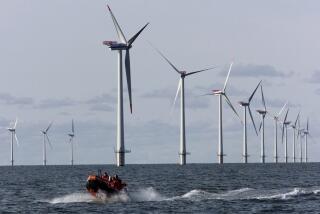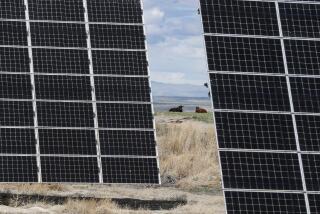Britain Tilting at Windmills as a Renewable Power Source
- Share via
DOUGLAS, Scotland — When the breeze blows the wrong way over the grassy hilltops above this quiet Scottish village, coal dust from the mines below can darken the air that powers rows of slim white wind turbines.
The two coal pits, providing one of Britain’s oldest and dirtiest forms of energy, are just hundreds of yards from the sleek, modern windmills that many environmentalists hope will lead the way toward a future of clean, renewable power.
Britain’s tiny wind-power industry is in the midst of a major expansion, with vast wind farms being constructed from the Scottish highlands to the Welsh countryside. More are on the way, thanks to new government rules requiring power companies to seek sources of renewable energy.
The wind sector will have to grow even more quickly if Britain is to achieve its goal of getting 10% of all electricity from renewable sources by 2010, part of Prime Minister Tony Blair’s plan to confront the threat of global warming.
Backers tout gusty Britain, one of Europe’s windiest nations, as a natural home for wind energy. The same stiff breezes that turn Londoners’ umbrellas inside out, they argue, could light homes and run refrigerators around the country.
“There’s more wind than anyone knows what to do with,” said Alison Hill, spokeswoman for the British Wind Energy Assn., an industry group. “Our wind speeds are much higher [than elsewhere in Europe]. I’m sure anyone who lives here will tell you that for free.”
Britain has long lagged behind its continental neighbors in developing ecologically friendly power sources. But Blair’s government is taking seriously the need to reduce emissions of carbon dioxide and other greenhouse gases that come from burning fossil fuels and are blamed for warming the Earth.
Blair said in February that confronting environmental problems like global warming was as important as battling terrorism. He argued that the Kyoto treaty to reduce greenhouse emissions -- rejected by President George W. Bush as too costly -- did not go far enough.
The prime minister pledged that Britain would seek to cut 60% from its carbon dioxide emissions by 2050, an ambitious goal that the Royal Commission on Environmental Pollution had recommended as necessary for the country to seriously confront climate change.
In a 2000 report, that same commission chastised Britain for failing to develop renewable energy as aggressively as other European countries.
Brian Wilson, who recently stepped down as energy minister, said that in the 1980s Britain missed its chance to become a leading wind-turbine manufacturer, a role that Denmark grabbed instead. He added that the government hopes to make Britain the main producer of equipment to harvest power from the ocean’s waves and tides, technology that is still being developed.
Germany leads Europe in wind-energy production, with enough turbines to generate about 12,000 megawatts of power, or 5% of its electricity, compared to Denmark with 2,900 megawatts, or 20% of its needs, and Britain with 552 megawatts, or less than 0.4%. The United States has capacity to produce 4,685 megawatts, or less than 1% of its electricity consumption, from wind.
One megawatt is enough to power between 500 and 600 European homes -- or 300 in the energy-guzzling U.S.. Energy-producing capacity is measured by the number of megawatts generated at any given instant.
Britain’s deregulated energy market, strong winds and last year’s renewable requirement for 2010 make it Europe’s most attractive locale for wind-energy development, consultants Ernst & Young said in a report.
The government is also investing millions to boost the sector, which produces no pollution, and is speeding approval for new projects. The 2010 target is “very challenging,” Wilson said. “We’re capable of meeting it, but it will take a tremendous effort and commitment.”
Scotland, with its heavy winds, mountains and open spaces, is at the heart of Britain’s wind aspirations. Many new sites are also planned in England and Wales.
At the Hagshaw Hill wind farm above the old Scottish coal town of Douglas, just south of Glasgow, the winds blow strong and steady even on a day that feels calm at sea level.
Twenty-six slim turbines, each 115 feet high, create no sound louder than a faint rustle as they turn. Sheep and cows graze in their shadows.
The 8-year-old wind farm, run by Scottish Power, is already being overtaken by new technology. Newer turbines are 330 feet tall and generate far more energy than Hagshaw Hill’s.
Many believe that the biggest wind-power boom will be in huge sites planned at sea, where winds are high and giant turbines can be installed without ruining neighbors’ views. Offshore wind-farm technology is less advanced than land turbines, however, and start-up costs remain high.
Supporters say wind energy is growing so fast that it will account for more than half of the 2010 renewable requirement, with hydropower contributing most of the rest. “We’re definitely behind” in developing renewable power sources, said Alan Mortimer, head of wind development at Scottish Power. “But we’re catching up.”
More to Read
Sign up for Essential California
The most important California stories and recommendations in your inbox every morning.
You may occasionally receive promotional content from the Los Angeles Times.










